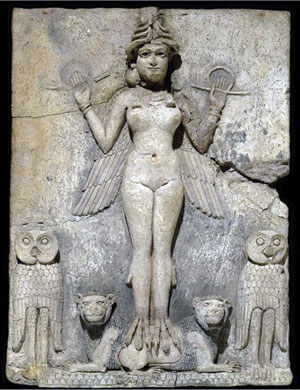

IF I knew enough secrets to lecture at the Triton Museum of Art in Santa Clara, I would probably do exactly what chief curator Preston Metcalf is doing right now: an eight-week series of Thursday teachings titled “Hidden Symbols of Art.”
This sentence hooked me: “From archaic, esoteric vocabularies to deliberate riddles and puzzles, from deceivingly benign decorative Greek patterns to the significance of a fallen shoe in a 19th-century American portrait, The Hidden Symbols of Art will be revealed.”
It all began last week, on the eve of Friday the 13th, and will continue on the next seven Thursdays, from 7 to 8:30pm. With the utmost of secrecy, I slithered like a serpent over to the Triton and infiltrated the first one, titled “Symbols of the Feminine.” The next installments will include dazzling topics like “Symbols of Life Beyond,” “Symbols of Demons and Gods” and “Symbols of Politics and Power.” Anyone can attend for a modest fee.
Twenty-five other seekers of hidden knowledge attended the opening lecture, which featured Metcalf showing what looked like a PowerPoint presentation on a large-screen TV behind him.
He illuminated various symbols in sculptures and paintings, from the Paleolithic era to more recent times, although it was not a chronological explanation, as the same symbols take on different meanings in various contexts throughout millennia. This theme forms the basis of this series: the difference between cultural interpretations of symbols and the more universal meanings they suggest.
For example, when it comes to a symbol like that now used by the Red Cross, your everyday run-of-the-mill ankh necklace, or the swastika Hitler stole from ancient India, one first has to look at each individual era and how locals understood the particular symbol. This constitutes the cultural or ethnic aspect of symbols, that is, the message conveyed by a symbol in regards to a specific culture or era.
But the more universal meanings are what Metcalf says he’s more interested in. Following the research of Heinrich Zimmer, Adolf Bastian, Joseph Campbell and Carl Jung, Metcalf juxtaposes the cultural interpretation of symbols against the “elementary interpretation” of symbols, that is, the metaphors behind the metaphors. For example, if one strips Nazism and Ancient Indian cultures away from the swastika, is there a more universal meaning to that particular symbol? Metcalf says yes.
Another example: Arguing whether or not Michelangelo put horns on the sculpture of Moses due to a simple mistranslation of the original Hebrew in Exodus 34:29 and 35 would constitute a debate on the cultural interpretation of the horns, as symbols. A journey into the elemental interpretation would reveal that animal horns were used as symbols in art throughout the ages—ancient Greece, India, Sumeria, Egypt, by Africans, Celts and others—because they were shaped like the moon and represented the divine feminine, the moon goddess. Metcalf says this is almost always what horns symbolized in ancient sculpture around the world.
With that, the first lecture began. Metcalf meticulously elaborated on numerous instances of the divine feminine in various media. In one example, if you cut an apple in half, not the common way, but perpendicular to the stem, you will essentially see a five-pointed star in the middle of the core.
According to Metcalf’s elementary interpretation, the star and the apple are related to the divine feminine and were incorporated in works of art long before the story of Adam and Eve. Hebrew numerology, Sumerian mythology, the phallus and the chalice, the moon goddess, the serpent and the female menstrual cycle—they’re all intertwined with the symbology of the five-pointed star inside the apple.
Like many art historians, Metcalf didn’t seem too interested in the 20th century, unfortunately. I would like to have seen more discussion of Timothy Leary’s cultural interpretation of the Garden of Eden story as the first drug bust—that is, he interpreted the apple as the first controlled substance.
In any event, it was a fascinating presentation. This Thursday, Metcalf will tackle the male side of things in a lecture titled “Symbols of Kingship and the Sun.”
The Hidden Symbols of Art
Thursdays, 7-8:30pm; $20
Triton Museum of Art, Santa Clara



